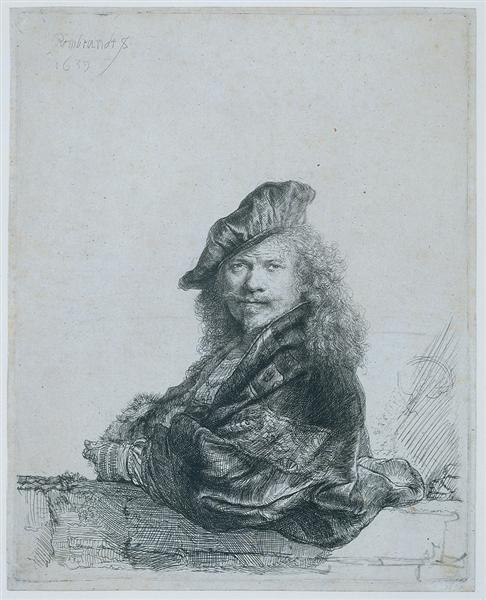Beskrivelse
Rembrandt's Self-Portrait Leaning on a Stone Sill, painted in 1639, represents one of the most intimate and moving expressions of the Dutch master's genius. In this work, Rembrandt presents himself in a direct and candid manner, using the reality of the self-portrait as a means of exploring his identity and his own humanity. Through his distinctive use of light and shadow, the painting reveals a psychological depth that transcends mere physical representation.
The composition shows Rembrandt in a fairly frontal plane, leaning on a stone sill, which reinforces the connection between the artist and the viewer. This compositional choice establishes a relationship of trust and intimacy; it seems that Rembrandt wants to share a personal moment, turning the self-portrait into a silent dialogue. The angle of his posture creates an imposing diagonal that guides the viewer's gaze from his head to the dark background, contributing to the sense of depth and three-dimensionality. The choice of the stone sill, an elemental architectural element, highlights his firmness and stability, while his own figure evokes a mix of vulnerability and resistance.
Rembrandt's use of colour in this work is masterful. Dark, earthy tones predominate, with a palette that includes browns, ochres and deep shadows contrasting with the brighter highlights on his skin, which seem to radiate light. This technique, known as chiaroscuro, is used to emphasise the features of his face, which in turn reveal the story of a man who has lived, bearing the marks of time and experience. The flesh tones, in particular, are rich and nuanced, adding a sense of vitality and authenticity.
Rembrandt is shown with a serene, almost reflective expression; his eyes, which seem to look through time, invite the viewer to contemplate not only his person, but also the emotions and thoughts surrounding his life and his art. The lack of adornment in his clothing and his unstyled hair contribute to the stripped-down naturalness of the portrait; here, the artist shows himself without pretensions, a reflection of his sincere approach to life and art.
In addition to the technical mastery it displays, this self-portrait is emblematic of the period in which Rembrandt was at the height of his career. During the 1630s, the artist engaged in a continuing exploration of his own identity, frequently portraying himself as a means of reflecting on his place in the world. Through these self-portraits, he not only documented his physical appearance over time, but also delved deeper into his human condition, capturing the essence of the experience of living.
This self-portrait joins a long tradition of self-portraiture in art history, where artists such as Albrecht Dürer and Vincent van Gogh also explored their identities through self-representation. However, the way Rembrandt combines personal introspection with his extraordinary technique sets him apart from his contemporaries. His ability to convey the vulnerability and strength of the human condition through a simple gesture, such as leaning on a windowsill, elevates this self-portrait to a level of emotional expression rarely achieved.
In conclusion, Self-Portrait Leaning on a Stone Sill is not only a masterpiece in terms of technique and composition, but it also offers a profound window into Rembrandt's soul as an artist and as a human being. Through his gaze and pose, the viewer is invited to reflect on the universality of the human experience, a theme that Rembrandt himself addresses with sincere and moving honesty.
KUADROS ©, a famous painting on your wall.
Hand-made oil painting reproductions, with the quality of professional artists and the distinctive seal of KUADROS ©.
Painting reproduction service with satisfaction guarantee. If you are not completely satisfied with the replica of your painting, we will refund 100% of your money.

